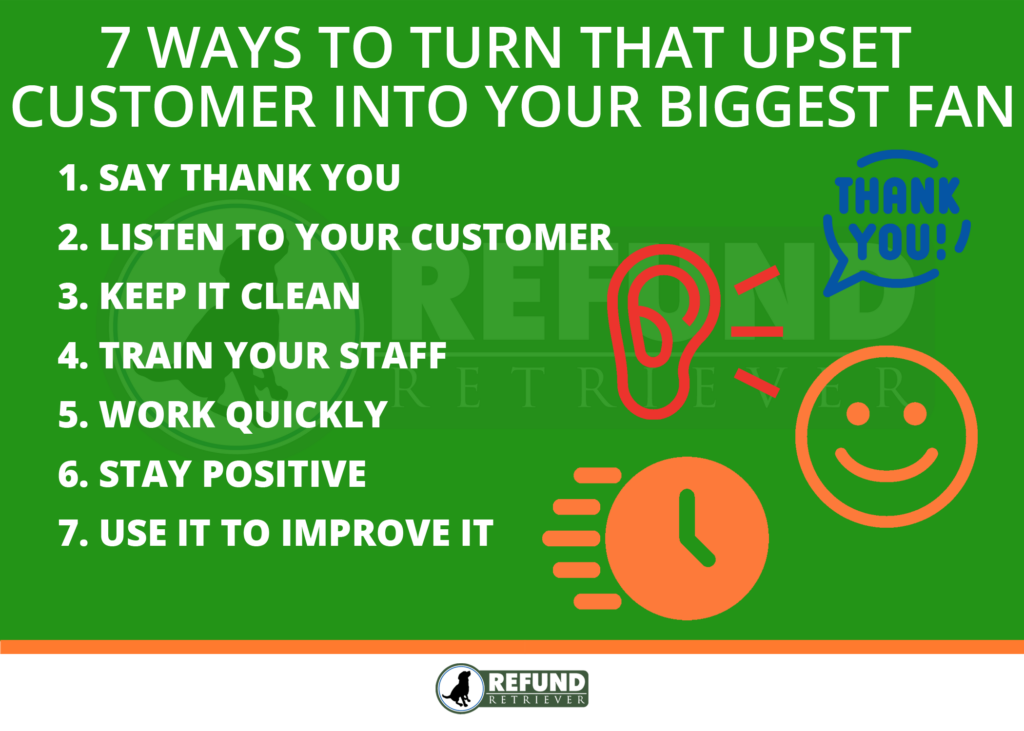How is it possible to turn an upset customer into your biggest fan? No matter how amazing your brand is, you occasionally encounter an upset customer. Whether demanding a full refund or just registering their displeasure, satisfying that customer is critical for maintaining your reputation.
Negative reviews and unhappy customers can erode trust in your brand and tank your sales numbers. Trying to make things right with those individuals can do the opposite, solidifying your trustworthiness and improving your sales.
While the specifics of the complaint may differ, one may hate your product, while another’s order may have been lost in shipping. There are a few ways you can deal with complaints in general. From adequately training your staff to simply listening to the complaint, here are seven ways to turn an unhappy customer into your biggest fan.

1. Say Thank You
When having a tense or negative interaction with a customer, it is essential to diffuse the situation. One of the most potent ways to do this is to thank the customer for reaching out. They may be contacting you with a complaint, but remember, any feedback you get (even negative) is valuable to you. The majority of unsatisfied customers will never say a word to you. They will take their money elsewhere. And what’s worse, they are likely to share their experience with people in their own lives. This means those people may also be prompted to take their money elsewhere!
Saying thank you will catch the complaining customer off-guard. It will automatically put you in a better position to find a resolution.
Be sure that your apology strikes the right tone, however. An overly enthusiastic thank you will likely register as disingenuous and make matters worse. Follow your thank you with an apology and an invitation to share more information about their experience.
2. Listen to your Upset Customer
If you do not hear the customer, it will be impossible for you to help repair the relationship. Many times, when there is a problem with a purchase, it can leave the customer in a heightened emotional state. You create an open space by letting them know you hear what they are saying and that you empathize with the experience. They will listen to you when you share any potential solution with them.
3. Keep it Clean – No Cussing
Keep things clean when dealing with a customer who is very upset and hurling insults. It is hard when someone curses and swears not to do the same, but you must keep yourself calm and professional.
While the customer is ranting at you, use the time to calm yourself down. Remember that they need to be heard. If you are taking a complaint over the phone, be sure the customer has the opportunity to tell their entire story before offering a solution. Trying to solve the problem before they are done sharing makes them feel dismissed and ramps up tensions.
If you are responding to a complaint that has come in via email or chat window, take a deep breath before responding. Read over what you have written to ensure your tone reflects no frustration or emotion.
You can resolve any negativity the customer may feel by being respectful and calm in the face of anger. This will help to turn an upset customer into your biggest fan.
4. Train Your Staff
One powerful step you can take to turn unhappy customers into returning customers is to train your staff to handle whatever may come their way. Establish a standard of professional behavior so they know what is expected of them.
Empower them to handle any situation. Inform your staff of established policies and procedures and give them the power to make decisions regarding returns and exchanges. When you empower staff to address situations as they see fit, they will be better at what they do. Competency translates to complaining to customers and making them feel like they are dealing with someone with the authority and ability to resolve the issue.
Anyone who handles these complaints, whether you or an entire team of customer service staff, is the first point of contact for an upset customer. By beginning the exchange with confidence, competency, and a little compassion, you can create an experience that makes people positively talk about you. Thus, turn upset customers into your biggest fans.
5. Work Quickly
Try to respond to customer complaints or concerns as quickly as possible. The longer a customer goes between the time of their complaint and the moment you answer, the more upset they become. The more likely they are to think you do not care.
And while most customers hope for a speedy response from customer service, they do not necessarily expect one. The faster you respond, the more pleasantly surprised they will be. Once again, this gesture of respect will create a more positive interaction.
And do not forget to monitor your social media pages. Customers may not reach out through your customer service channels to complain; they may blast you online instead. How you respond to these comments impacts the complaining customer and will affect all those who read it.
6. Stay Positive with the Customer
When you find yourself starting to feel negatively towards your customer, try to flip the script. Instead of finding their complaint annoying, frame it in a positive light. The customer is not being impossible; they are being passionate. Once you can view the complaint more favorably, you can work together toward an agreeable solution. Suppose customers feel you understand the complaint and are not being dismissive or condescending again. In that case, they are more likely to walk away happy and Turn Upset customers into Your Biggest Fans.
7. Use the Experience to Improve It
Every single complaint you get is an opportunity for improvement. It is worth listening to when a customer complains about product quality or shipping method.
And it is essential to investigate whether specific complaints happen often. If you are getting the same complaint repeatedly about your product, then there is likely something you need to fix about your product.
Being able to tap into complaints and make adjustments mitigates future complaints about the same thing and creates an avenue for a previously dissatisfied customer to make a return to you. Improving products and services shows these people that you are willing to listen to your customer base, which enhances your trustworthiness in a big way.
Turn Upset Customer Into Your Biggest Fan
Unhappy customers are never fun to deal with. No company likes to hear when and how they have failed. Additionally, no person likes to be responsible for addressing that failure. But unhappy customers can be a real asset to your brand. You can Turn Upset Customer Into Your Biggest Fan by following the steps above. While you want to avoid customer complaints, you do not need to be afraid of them. As a brand, if you can provide someone with a truly surprising and positive exchange, they will talk about it. Word of mouth and peer reviews still drive the majority of purchases.

